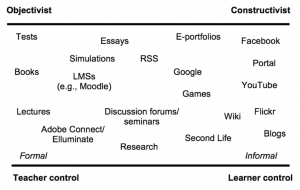Social Learning. Buzz word, right? Well, yes and no. The truth is somewhere in the middle. To get down to it, let’s see some actual facts and concepts that can be useful in the real world, and not just for the hype of it.
First, a quick recap. Social Learning is one of the four trending topics in the e-Learning industry right now (others being Mobile, Gamification and Bit-Size eLearning). Sure, these are buzzwords also, but the truth is that these three are easily digestible when it comes to thinking applications to learning processes and e-learning technologies. Social Learning is vague. Roberta Gogos previously posted a great definition of what social learning is, but where do we go from here? How can we use Social Learning concepts to leverage the learning process and improve the average learning curve?
Sometimes you do not have to do anything. You know, things just happen. Students communicate with each other either within the context of learning or not. They interact, and collectively develop a deeper understanding of the subject than the average individual would. But why not enhancing this natural social activity to amplify its effect? And how?
The instructor is the key, as it has always been. Creating hubs of communication and interaction within social networks can provide instructors with an entry point to stimulate social interaction, and students a place where they can initiate on their individual quest; either for deeper comprehension, or for supporting fellow students and learning as a side-effect of the process. Hooking up with wider related communities or structures will also help student groups (even if we are talking about micro-groups) to relate and indulge into sharing and learning.
Technology is also a prime factor. Let’s face it; there is no “learning” today without a bit of “e-” in front of it. Technology gives instructors the means to reach out to students. But, It should also provide the means for students to reach out to each other. In most cases, it does so. Online social networks have helped a lot, but any type of system should promote interaction among students and among communities, and if possible, do so in a learning-oriented manner. Control should move away from the instructor and be handed to the student, and technology should enable to do exactly this. Depending on the actual subject, Social Learning also moves away from the Objectivistic way of teaching and towards an approach resembling Constructivism theory with a social twist. In plain English; both the learning process as well as the tools used for it, should enable the student to discover and experience knowledge through interaction with others.
If we were to place current technology and services on a map, it would probably look like the following figure.
So, where does this leave us in regards to the actual choices we make as instructors or technology providers? Well, here is a penny’s worth fragment of wisdom:
- Focus on interactivity, either within context or out of it. Do not hesitate to use existing social networks (online or offline) to do so.
- Use e-Learning technology that provides for interactivity among learners. Technology that integrates well with existing online social networks will be a great plus and will help to provoke inter-group extended learning through all available channels of communication.
- Ignite interaction, as an instructor, by utilizing the above on a regular basis.
- Provide for cross-group interaction with domain-specific communities.
Social Learning may be “fuzzy” and “buzzy” at the moment. Nonetheless, it is something real. Beyond canned courses and test. The notion that through social interaction comes a deeper understanding of things is true, as it always was. But in our social era, it is more important than ever. And these social learning strategies will help your understand why, in practice.
“There is no end to education. It is not that you read a book, pass an examination, and finish with education. The whole of life, from the moment you are born to the moment you die, is a process of learning.” – Jiddu Krishnamurti




